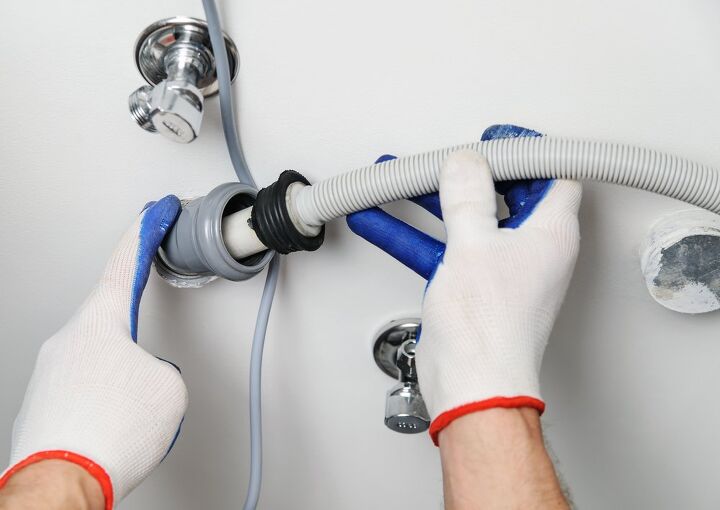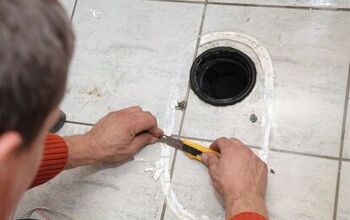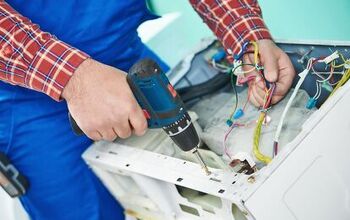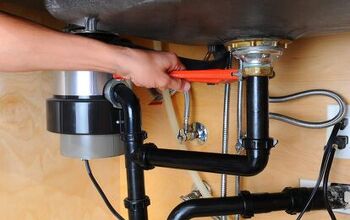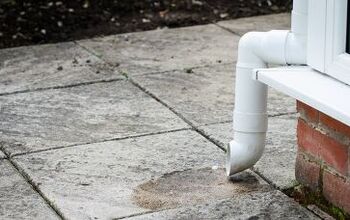What Size Drain Pipe For A Washing Machine?

Running a washing machine is simple work, you throw the clothes in, dump the soap and start the machine. The rest is the machine’s job. However, installing a washer machine is a different story. There are many different components to this, to which the size of the drainpipe is perhaps the most important. So, what size drain pipe do you need for your washer?
According to the Universal Plumbing Code, you need to have a 2-inch drain pipe with a p-trap for all plumbing fixtures and appliances in your home, which includes your washer. The drain line should have a slope of 14 inches per foot of pipe to ensure proper drainage of the wastewater. Check for adequate venting of the P-trap and standpipe.
In this article, we will talk about everything you need to know involving your washing machine drain pipe. This will help you ensure everything is up to code and in proper working order. When in doubt, always hire a professional!
What are the Drain and Trap Requirements for a Washing Machine?
All washing machines require a 2-inch drainpipe. To manage the quick drainage of current washers, the previous requirement of a one 1/2-inch pipe is insufficient. A P-trap is also required for all plumbing fixtures and appliances, including washing machines.
You should place the trap 6 to 18 inches above the ground, with a standpipe 18 to 30 inches above that. After a 2-inch trap, a horizontal run of twice the pipe diameter, or 4 inches, is necessary to prevent it from acting as an illegal S-trap.
Can You Use a 32mm Drain Pipe for a Washing Machine?
Because the drain hose will have water running under pressure and the waste pipe will not be free-flowing, the cross-sectional area will be larger. For 32mm, it will be roughly 2.5 times.
Are Washing Machine Waste Pipes Universal?
Washing machine waste pipes are indeed universal as all of them have the same code that they need to abide by. However, depending on whether your unit is a special sort of machine, you may or may not have a specific drain pipe that fits it. In that circumstance, a universal waste pipe would not fit that machine; but that is a rare occurrence.
How Much Slope Does a Washer Drain Need?
Drains must flow downhill into your sewer, as you are undoubtedly aware. Do you, however, understand the proper slope? Any drain line should have a slope of 14 inches per foot of pipe.
In other words, the pipe should decrease 14 inches vertically for every foot it goes horizontally. Many drains have an insufficient or excessive slope. That is correct; there is such a thing as too much slope in drain lines. Because liquids move too quickly and leave the solids behind, over-sloped pipes (more than 12 in. per ft.) are just as likely to clog as under-sloped pipes.
Why is it so expensive? Drain lines that do not have the right slope are more likely to clog. This necessitates either dumping a lot of harsh chemical drain cleaner down the drain (which can cause corrosion) or calling a professional plumber to clear the drain on a regular basis.
Do You Need to Vent the Trap on Your Washing Machine?
Unvented traps are another common DIY plumbing blunder. Drain traps act as a barrier between your home and the sewer system. They prevent rodents and dangerous methane gas out of your house. Many do-it-yourself plumbers have no idea how a proper trap should work.
Some install an S-trap in their sink drain pipe when remodeling their bathroom or kitchen. These traps are made up of two traps joined in the shape of an “s.”
S-traps are not adequately vented, and the water from the trap can be siphoned out, destroying the water barrier within the trap. Instead, a properly vented P-trap should be installed.
The water in the trap can be siphoned out if there is not an appropriate outlet. Your sewer might leak explosive methane gas into your home when this happens, posing a fire hazard. Vermin can also creep up your drain and into your house.
What is Code for a Washing Machine Drain?
The requirement for washing machine drain size is 2 inches, according to the Universal Plumbing Code. The pipe should be between 18 and 30 inches high from the floor, while the P-trap should be between 6 and 18 inches high. These standpipes link to the sewage system in the residence and should be vented as well.
Do I Need a Standpipe for Washing Machine?
Installing a standpipe is the proper way to drain a washing machine. This is a vertical pipe that links to a P-trap, which then connects to the drain. The top of the standpipe must reach above the washing machine’s overflow level and be properly ventilated.
When the laundry room has unfinished walls, installing a standpipe is not a tough plumbing task when the laundry room has unfinished walls. Simply run a horizontal pipe from the drain to the washer with a 1/4-inch-per-foot slope toward the drain. The P-trap and standpipe are then glued on, and the standpipe is strapped to a stud.
Does the Standpipe on a Washing Machine Need to be Vented?
The plumbing code demands that you vent a P-trap whenever you install one, or else negative pressure in the pipes will suck the water out and leave the trap worthless. Furthermore, skipping the vent is a surefire way to end up with a clogged drain.
The vent must rise a minimum distance from the trap, which varies depending on the size of the drain and vent pipes you employ; for a 2-inch drain line, this distance is normally 5 feet.
Although venting a 2-inch drain using a 1 1/4-inch vent pipe is legal, utilizing a 1 1/2-inch pipe reduces the risk of the drain overflowing or the trap emptying.
Does a Washer Drain Have to Have a P-Trap?
You’re putting yourself at risk if you make a waste pipe for any appliance that has to drain, such as a washing machine, and the drain doesn’t contain a P-trap. The pool of water at the bottom of the trap efficiently locks sewer gases inside the pipes, but if you do not use it, the gases will have a direct path into your home.
Some sewage gases, such as methane, are combustible in addition to being packed with hazardous organisms that can be inhaled. If the washer is in a closed space, omitting the trap could really cause a fire hazard.
Does a Washing Machine Waste Pipe Need to be Elevated?
Generally, the drain hose from the machine should be brought above the highest water level of the machine’s tub where it exits at the back bottom of the machine. Water may still siphon out if the hose is pressed snugly into a standpipe rather than a sink.
You can cut a small hole in the bend of the hose that would fit over the sink edge and slide a cheap pen barrel half into the hole (+ sealant if needed), and face it in the direction of the flow. The hose will usually be high enough where it exits from the machine’s back top to prevent water from siphoning out.
Some machines, mostly older models, were an exception; one type has an outlet valve, while another filled water directly into a non-perforated inner tub. When the machine was spun, water spun out over the top of the inner wash/spin tub into the outer tub, from which a bottom opening led straight to the drain; no pump was required.
Does a Washing Machine Drain Hose Need a Loop?
A washing machine drain does not have to have a loop because you can simply insert the drain hose into the raised pipe, which creates an air gap and prevents the water in the washing machine from being sucked out. Because it does not have a P-trap, you elevate a loop in a dishwasher line and bring it up beneath the counter.
You do not need to put a loop in the hose since it has an air gap, so you do not have to worry about bad water getting sucked back in when you put it in the high pipe of the washing machine. Because a dishwasher lacks a P-trap, if you do not install a loop or elevate it, dirty water can be sucked back into the machine, potentially contaminating it.

Heather is a passionate writer who loves anything DIY. Growing up, she learned everything from home repairs to design, and wants to share her tips with you. When she's not writing, she's usually hiking or searching for her next DIY project.
More by Heather Robbins



